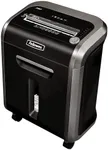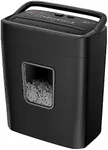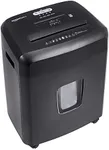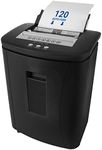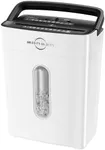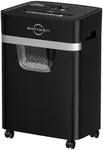Buying Guide for the Best Cross Cut Shredder
Choosing the right cross-cut shredder involves understanding your specific needs and the key features that will best serve those needs. Cross-cut shredders are essential for securely disposing of sensitive documents by cutting them into small pieces, making it difficult for anyone to reconstruct the information. To make an informed decision, consider the following key specifications and how they align with your requirements.Sheet CapacitySheet capacity refers to the number of sheets a shredder can handle at once. This is important because it determines how quickly you can shred documents. Shredders with a lower sheet capacity (around 5-10 sheets) are suitable for personal or light office use. Medium capacity shredders (10-20 sheets) are ideal for small offices, while high capacity shredders (20+ sheets) are best for larger offices with heavy shredding needs. Consider how often and how much you need to shred to choose the right capacity.
Run Time and Cool Down TimeRun time is the duration a shredder can operate continuously before needing to cool down, while cool down time is the period it needs to rest before it can be used again. This is crucial for efficiency, especially in busy environments. Short run times (2-5 minutes) with longer cool down times (20-40 minutes) are typical for personal use. For small to medium offices, look for shredders with moderate run times (10-20 minutes) and shorter cool down times (10-20 minutes). Heavy-duty shredders can run continuously for 30 minutes or more with minimal cool down. Match the run time and cool down time to your shredding volume and frequency.
Security LevelSecurity level indicates how small the shredder cuts the paper, which affects how difficult it is to reconstruct the shredded documents. This is measured by the P-rating scale, from P-1 (least secure) to P-7 (most secure). For general home use, a P-3 or P-4 rating is usually sufficient. For sensitive personal information or small office use, a P-4 or P-5 rating is recommended. For highly confidential documents, such as those in legal or financial sectors, a P-6 or P-7 rating is necessary. Choose the security level based on the sensitivity of the documents you need to shred.
Bin CapacityBin capacity refers to the volume of shredded paper the shredder can hold before it needs to be emptied. This is important for convenience and efficiency. Smaller bins (up to 5 gallons) are suitable for personal use, as they need to be emptied more frequently. Medium bins (5-10 gallons) are good for small offices, while larger bins (10+ gallons) are ideal for high-volume shredding environments. Consider how often you want to empty the bin and the volume of shredding you do to choose the right capacity.
Noise LevelNoise level is the amount of sound the shredder produces while operating, measured in decibels (dB). This is important for maintaining a comfortable working environment. Shredders with lower noise levels (under 60 dB) are ideal for shared or quiet spaces. Medium noise levels (60-70 dB) are acceptable for most office environments. Higher noise levels (above 70 dB) might be suitable for industrial settings but can be disruptive in an office. Consider the noise tolerance of your environment when choosing a shredder.
Additional FeaturesAdditional features can enhance the functionality and convenience of a shredder. Look for features like jam prevention, which helps avoid paper jams and reduces downtime. Auto-feed allows you to load a stack of papers and walk away, saving time. Safety features, such as automatic shut-off when hands are near the feed opening, are important for preventing accidents. Energy-saving modes can reduce power consumption when the shredder is not in use. Consider which additional features will be most beneficial for your specific needs.




